
John Watling's Distillery
by
Terry & Kathy Sullivan
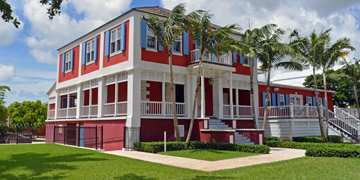 Summary: If on a cruise to Nassau, fit in a visit to John Watling´s Distillery for a tour and tasting of unique Bahamian rums. The distillery is a short distance from the Cruise Terminal. A tour of the Buena Vista house and distillery is a walk through Bahamian history. After the tour enjoy tasting unique rums showcasing the color spectrum of rums.
Summary: If on a cruise to Nassau, fit in a visit to John Watling´s Distillery for a tour and tasting of unique Bahamian rums. The distillery is a short distance from the Cruise Terminal. A tour of the Buena Vista house and distillery is a walk through Bahamian history. After the tour enjoy tasting unique rums showcasing the color spectrum of rums.
We embarked from the Carnival Pride and began our walking journey to John Watling´s Distillery, a bit over a mile from where our ship docked. On the day of our visit the temperature in Nassau was very hot and we should have taken a taxi the short distance; some of the walking was uphill. We had written directions and discovered good signage for the distillery. When we arrived at the distillery, we walked up the stairway of Buena Vista house and were warmly greeted by a staff member. Within seconds we were offered a tasting of a cold John Watling's Piña Colada that was delicious and began to revive us from our heat drenching amble to the site.
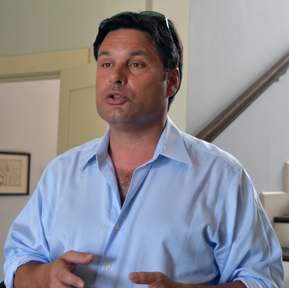 We waited in the air conditioned tasting room to meet Pepin Argamasilla, one of the distillery owners. In a few minutes, we joined other visitors on a tour led by Pepin, where we learned about the history of the place and aging of the rums.
We waited in the air conditioned tasting room to meet Pepin Argamasilla, one of the distillery owners. In a few minutes, we joined other visitors on a tour led by Pepin, where we learned about the history of the place and aging of the rums.
History
John Watling’s Distillery offers visitors a delightfully, linear history in the historic Buena Vista house beginning with 1492 when Christopher Columbus visited The Bahamas. The island he first visited was known as San Salvador. A room close to the tasting room offers visitors images and plaques describing the important history of the region.
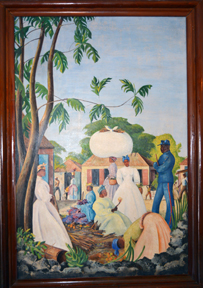 The Buena Vista Estate was built in 1789 on New Providence. Much importance is made of the history of this land. The 1789 date has added significance, as it is the same year the French Revolution began and George Washington’s first year as President of the United States. A large framed image by Franklin Bennet c 1940s is titled "Working at the Buena Vista Estate."
The Buena Vista Estate was built in 1789 on New Providence. Much importance is made of the history of this land. The 1789 date has added significance, as it is the same year the French Revolution began and George Washington’s first year as President of the United States. A large framed image by Franklin Bennet c 1940s is titled "Working at the Buena Vista Estate."
The distillery was named for John Watling, who was renowned as an English buccaneer (pirate) who inhabited the region. John Watling passed away in 1691 as the result of a gun shot. When the owners of John Watling’s Distillery opened the distillery in 2013, they chose to name the distillery after John Watling. It is interesting to note that John Watling was reputed to be a pirate. According to the distillery's website, “Watling, who was described as a 'stout seaman' was also known as the 'Pious Pirate' since he observed the Sabbath and forbade gambling, throwing dice and the use of gaming boards.” Watling changed the name of the island from San Salvador to Watling which was eventually changed again.
Today, John Watling´s Distillery is owned by Pepin and his cousin Jose Portuondo. Pepin is from Canada while Jose is from the Bahamas. When Bacardi left the Bahamas, Pepin and Jose wanted to produce a rum in the Bahamas. Pepin commented that they wanted to “Give the Bahamas a rum they would be proud of.” Pepin’s father was a master blender. Pepin said, “The art form in the rum industry is the master blender.” John Watling´s Distillery’s master blender has two distillates to work with. One is made using a continuous column still while the other is made from a pot still.
 Production
Production
Our group tour was led from the Buena Vista house to the production and aging building. Visitors enter on a loft overlooking a large area. Used bourbon barrels were stacked upright housing rum. Some barrels were also stacked on their sides forming a four barrel high pyramid. Various sizes of stainless steel tanks were at the opposite end of the area. Rum is made from pressed sugar cane molasses. Since the Bahamas does not have a sugar cane industry, the master blender sources distillates from other British Caribbean countries.
Prior to barreling, the distillate is charcoal filtered. Some of the charcoal used to filter the distillate is made from locally carbonized coconut husks. After the filtering, the distillate is aged in American white oak barrels. The master blender will keep the rums in barrels until they are ready to be bottled.
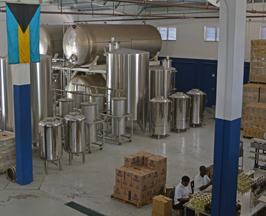 The museum-like feel continued on the loft. Signs depicted the different areas of the production area with a photo of the space and a description of what happens there. The sign for angel’s share referred to the barrel area. The distillate is aged in white oak barrels for a number of years. During these years, some of the rum evaporates from the barrels. Unlike wine where a winemaker will top off the barrel to keep it full, the distiller does not top off a barrel. The rum that evaporated is not replaced and is referred to as the angel’s share.
The museum-like feel continued on the loft. Signs depicted the different areas of the production area with a photo of the space and a description of what happens there. The sign for angel’s share referred to the barrel area. The distillate is aged in white oak barrels for a number of years. During these years, some of the rum evaporates from the barrels. Unlike wine where a winemaker will top off the barrel to keep it full, the distiller does not top off a barrel. The rum that evaporated is not replaced and is referred to as the angel’s share.
On the loft, three small barrels had barrel heads made of clear plastic. You can see the rum inside. These barrels were about a quarter full and they could turn from side to side. Visitors turn the barrels gently to cause the rum to move. Bungs were removed from the bung hole so visitors could smell the rum. The aromas for the rums in barrels were different. The barrels had rums that were aged for two years, three years and five years. Pepin exclaimed that the rums aged for five years in the Bahamas are equivalent of 12 years of scotch aged in Scotland. Because of the Bahamian climate, about five percent of the rum evaporates per year compared to about 1.4 percent of scotch evaporating per year.
At the time of our visit, workers were hand bottling rum with John Watling´s unique bottling. Once bottled and sealed with a stopper, the workers attached a hand woven sisal plait on the neck of the bottle. The sisal adorns the bottle and is a gentle reminder of the past.
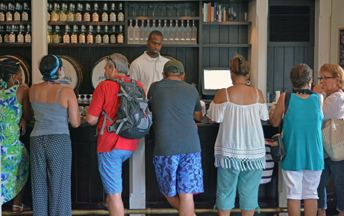 Tasting
Tasting
Back in the tasting room, we sat at a table with Pepin. We tasted four rums that showcased a color range of rums from pale yellow to dark amber. Three glasses of rums were placed on a laminated tasting sheet with notes about the rums. The color differences were quite evident. Pepin also wanted us to taste a fourth rum, a single barrel rum that was uncut. Cutting a spirit refers to adding water to the spirit prior to bottling. The water lowers the rum to 40% or 80 proof. In the case of the single barrel rum, water was not added and the rum retained its 66.2% alcohol or 132 proof.
The Pale Rum was aged for two years. The light yellow color had aroma notes of nuts and molasses. Tasting it straight, the rum was very smooth and had notes of vanilla and a hint of lemon. The Amber rum was aged for three years. The amber colored rum had an aroma of nuts and vanilla. The taste had a very silky mouthfeel and notes of dried fruits. This rum reminded us of a bourbon.
 The Buena Vista Rum was aged for five years. The rum had an amber color with red hue. The rum was velvety and offered nut, vanilla, caramel and dried fruit notes. This rum reminiscent of cognac. The Single Barrel Rum was uncut with a 66.2% alcohol. The amber colored rum is meant for sipping. The rum had a velvety mouthfeel and was very fruity with alcohol sweetness. The dried fruit notes reminded us of pineapples, oranges and peaches. There was a bit of heat on the finish.
The Buena Vista Rum was aged for five years. The rum had an amber color with red hue. The rum was velvety and offered nut, vanilla, caramel and dried fruit notes. This rum reminiscent of cognac. The Single Barrel Rum was uncut with a 66.2% alcohol. The amber colored rum is meant for sipping. The rum had a velvety mouthfeel and was very fruity with alcohol sweetness. The dried fruit notes reminded us of pineapples, oranges and peaches. There was a bit of heat on the finish.
In addition to the rums, John Watling´s Distillery also makes a vodka. The John Watling´s Distillery rums and vodka are distributed in the Bahamas. Pepin became philosophical and thought about the word spirit. John Watling´s Distillery has the spirit of alcohol wrapped in the spirit of the Bahamas and the spirit of the Buena Vista house. In addition to tasting the spirits, visitors can celebrate Bahamian culture and learn about this country, its people and the rum.
John Watling´s Distillery
Delancy Street, Nassau, Bahamas
Article written August 2016
Visit these distilleries that advertise with Distilling - Wine Trail Traveler.
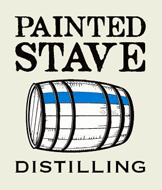 |
 |
|
| Painted Stave | Pinch Gut Hollow Distillery |
